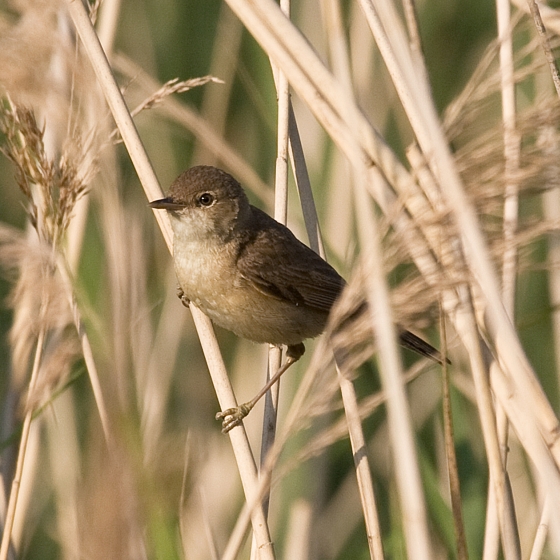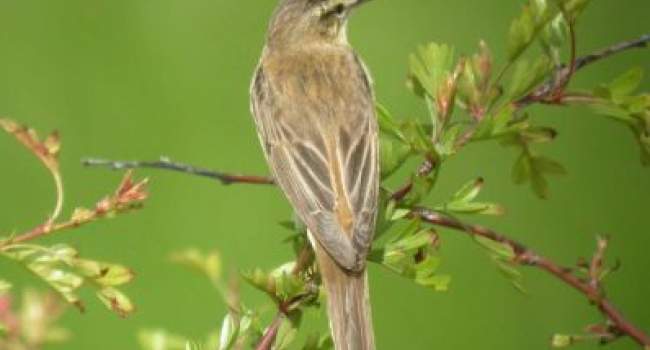Reed Warbler
Acrocephalus scirpaceus (Hermann, 1804)
RW
 REEWA
REEWA  12510
12510

Family: Passeriformes > Acrocephalidae

The Reed Warbler is a bird of reedbeds, where its rhythmic song can be heard from April to September.
A recent colonist to southern Scotland, the Reed Warbler is largely confined to reedbeds and riverside reed fringes of England, Wales and eastern parts of the island of Ireland. The Reed Warbler is double brooded, laying two clutches of eggs during late spring and midsummer. It is a common host species of the Cuckoo.
UK Reed Warbler numbers increased in the latter part of the 20th century, stabilising in the early-2000s. Most Reed Warblers leave the Britain & Ireland by mid September to spend the winter in Africa, south of the Sahara Desert.
Exploring the trends for Reed Warbler
Our Trends Explorer will also give you the latest insight into how the UK's Reed Warbler population is changing.
trends explorerIdentification
Reed Warbler identification is sometimes difficult. The following article may help when identifying Reed Warbler.
SONGS AND CALLS
Listen to example recordings of the main vocalisations of Reed Warbler, provided by xeno-canto contributors.
Song
Develop your bird ID skills with our training courses
Our interactive online courses are a great way to develop your bird identification skills, whether you're new to the hobby or a competent birder looking to hone your abilities.
Browse training coursesStatus and Trends
Population size and trends and patterns of distribution based on BTO surveys and atlases with data collected by BTO volunteers.
CONSERVATION STATUS
This species can be found on the following statutory and conservation listings and schedules.
POPULATION CHANGE
This species has an unusually clumped distribution, with very high breeding concentrations in Phragmites reedbeds, where numbers are very hard to census. CES, which has many sites in reedbeds, ought perhaps to be a better measure of population change than either CBC/BBS or WBS/WBBS, where the species is encountered mainly at low density or in linear habitats. Both CBC/BBS and WBS/WBBS show progressive strong increases. CES, however, shows a decline from 1983 until the early 1990s, followed by a partial recovery, and another more recent decline. Population increase, as indicated by the census work, accords with the remarkable range expansion the species has achieved since the 1960s, as recorded by atlas projects. West Wales, northwest and northeast England were colonised, as was the east coast of Ireland, between 1968-72 and 1988-91 (Gibbons et al. 1993), and the species is now regular as far north as the Tay reedbeds (Robertson 2003, Balmer et al. 2013). Numbers across Europe have been broadly stable since 1980 (PECBMS: PECBMS 2020a>).
| UK breeding population |
+105% increase (1967–2020) 
|
Exploring the trends for Reed Warbler
Our Trends Explorer will also give you the latest insight into how the UK's Reed Warbler population is changing.
trends explorerDISTRIBUTION
The majority of the Reed Warbler population in Britain still breeds to the south of South Yorkshire and Lancashire, although gradual northward and westward range expansion have been underway for several decades. The highest breeding densities are found in eastern England, particularly in the Fens where there are many Phragmites-dominated areas for breeding. Small numbers breed in Ireland.
Occupied 10-km squares in UK
| No. occupied in breeding season | 1107 |
| % occupied in breeding season | 37 |
| No. occupied in winter | 13 |
| % occupied in winter | 0.4 |
European Distribution Map
European Breeding Bird Atlas 2
Breeding Season Habitats
| Most frequent in |
Reedbed 
|
| Also common in | Estuaries |
Relative frequency by habitat
Relative occurrence in different habitat types during the breeding season.

DISTRIBUTION CHANGE
The Reed Warbler's British breeding range has expanded by 40% since the 1968–72 breeding atlas. Northward range expansion saw Reed Warblers breed in Scotland for the first time in 1987 in the large Tay reedbeds.
Change in occupied 10-km squares in the UK
| % change in range in breeding season (1968–72 to 2008–11) | +41.4% |
| % change in range in winter (1981–84 to 2007–11) | +25% |
SEASONALITY
Reed Warbler is a summer visitor, arriving from mid April with autumn migration extending into early October.

Movement
Information about movement and migration based on online bird portals (e.g. BirdTrack), Ringing schemes and tracking studies.
RINGING RECOVERIES
View a summary of recoveries in the Online Ringing Report.
Foreign locations of birds ringed or recovered in Britain & Ireland

Biology
Lifecycle and body size information about Reed Warbler, including statistics on nesting, eggs and lifespan based on BTO ringing and nest recording data.
PRODUCTIVITY & NESTING
Exploring the trends for Reed Warbler
Our Trends Explorer will also give you the latest insight into how the UK's Reed Warbler population is changing.
trends explorerSURVIVAL & LONGEVITY
View number ringed each year in the Online Ringing Report
Maximum Age from Ringing 
|
12 years 11 months 21 days (set in 2001) 
|
Typical Lifespan 
|
2 years with breeding typically at 1 year |
Adult Survival 
|
0.47±0.01  
|
Exploring the trends for Reed Warbler
Our Trends Explorer will also give you the latest insight into how the UK's Reed Warbler population is changing.
trends explorerBIOMETRICS
Wing Length 
|
Adults | 65.6±1.8 | Range 63–69mm, N=33113 |
| Juveniles | 64.7±1.8 | Range 62-67mm, N=33342 | |
| Males | 66.4±1.7 | Range 64–69mm, N=10905 | |
| Females | 64.7±1.6 | Range 62–67mm, N=9169 |
Body Weight 
|
Adults | 11.5±1 | Range 10.2–13.4g, N=27827 |
| Juveniles | 11.4±1.551 | Range 9.90–13.7g, N=28300 | |
| Males | 11.3±0.7 | Range 10.3–12.5g, N=8909 | |
| Females | 11.8±1.2 | Range 10.1–14.0g, N=7595 |
Feather measurements and photos on featherbase 
CODES & CLASSIFICATION
Ring size 
|
A |
Field Codes 
|
2-letter: RW | 5-letter code: REEWA | Euring: 12510 |
For information in another language (where available) click on a linked name
Research
Interpretation and scientific publications about Reed Warbler from BTO scientists.
CAUSES AND SOLUTIONS
Causes of change
Breeding performance has increased, with some suggestion that this may be related to warming climate or improved habitat management, although the evidence for this is sparse.
Further information on causes of change
There is some evidence to suggest that this species may have benefited from warmer climates. Reed Warblers have shown a trend towards earlier laying (see above), which can be partly explained by recent climate change (Crick & Sparks 1999, Halupka et al. 2008). Halupka et al. (2008) analysed changes in breeding parameters of Polish Reed Warblers, studied during 12 breeding seasons between 1970 and 2006, and found that the onset of breeding advanced with warming temperatures, although the end of breeding did not change, thus resulting in an extension of the breeding season. The lengthening of the laying period by about three weeks meant that more birds were able to rear second broods. Furthermore, mean temperature during May-July correlated negatively with the proportion of nests that failed and there was some evidence of a positive relationship with the number of fledglings. Eglington et al. (2015) also suggest that the spread of Reed Warbler may be due to higher productivity stemming from increased temperatures. Experimental provision of supplementary food at two sites in South Wales led to advanced laying and increased productivity, indicating that food supply may be a limiting factor; hence suggesting a mechanism through which the trends may have occurred (Vafadis et al. 2016).
Further research found that food-supplemented pairs spent more time incubating and showed a quicker response to the (simulated) presence of a predator (Vafadis et al. 2018).
The demographic data show a decrease in nest failures at the chick stage, although no trend was detected in the numbers of fledglings per breeding attempt, and a small improvement is apparent in CES productivity, although there is no available evidence to suggest that this is related to changing climate.
However, the suggestion that climate change has been a positive driver for this species is contradicted by modelling which concluded instead that the overall impact on the UK long-term trend for this species may have been negative, due to the negative effect of autumn temperatures in Spain (Pearce-Higgins & Crick 2019).
Both CBC/BBS and WBS/WBBS trends show progressive moderate increases perhaps linked to increasingly sensitive management of small and linear wetland sites. Thaxter et al. (2006) analysed data from two sites and found indirect evidence linking good habitat management to local abundance and survival.
As this species is a migrant it is possible that factors operating outside the breeding season may be responsible for changes in population in the UK. Thaxter et al. (2006) found that, unlike in the Sedge Warbler, rainfall in the Sahel region of West Africa did not account for variation in survival rates over time and did not correlate with variation in adult Reed Warbler abundance in the UK.
Julliard (2004) found that the French Reed Warbler population appears to be strongly regulated and that population growth rate was more influenced by survival rate than by recruitment.
Information about conservation actions
The population of this species increased between the 1970s and the early 2000s and has since been stable, hence it is not a species of concern and no conservation actions are currently required.
Continued improvements to wetland habitats and in particular the provision (and ongoing management) of Phragmites reedbeds are likely to continue to benefit this species which nests in very high concentrations within reedbeds. A study in the Netherlands found that Reed Warblers preferred uncut reeds to cut reeds when choosing nest territories and that the areas of uncut reed had higher nesting densities and lower predation rates (Graveland 1999).
The provision of supplementary food at breeding sites can help improve productivity (see Causes of Change section, above), although given the recent trends there is no evidence that food shortages are a significant problem currently for the UK population as a whole.
Links to more information from ConservationEvidence.com
Would you like to search for another species?













Share this page